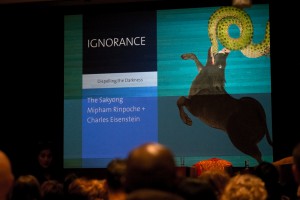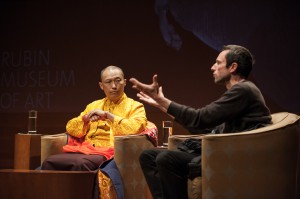Thursday
Sakyong and FamilyThe Water Level is Rising
by Sarah Lipton
Shambhala Times Editor-in-chief
At a sold out event at the Rubin Museum, Sakyong Mipham Rinpoche sat on stage for an hour-long dialogue with Charles Eisenstein, author of “Sacred Economics”. With fifty percent of the people seeing the Sakyong for the first time and the other half seeing Charles for the first time, this was an historic event both for the Sakyong and the Rubin Museum. As part of a series of talks on ignorance the Sakyong and Mr. Eisenstein were invited to ruminate on “Dispelling the Darkness of Ignorance.”
The Rubin dedicates itself to exploring how ideas from the Himalayas travel here to the West. Inviting a dialogue about enlightened expression between a “lama” and an “activist,” is the typical currency for the organization. The Rubin’s producer, Tim McHenry, introduced the evening by asking the question, “What is ignorance?” He went on to ask how we can improve the lives of others, saying, “Is it through knowledge?”
After a dramatic reading of a passage on wisdom from the Sakyong’s book The Shambhala Principle, Tim invited the Sakyong and Charles to the stage to engage in what turned out to be a dynamic conversation. Topics ranged from the rising level of the water (metaphorically and not) to today’s blossoming of wisdom traditions in response to the shifts that are occurring on an environmental and economic level. They both spoke about the power of story, Charles expressing it as a powerful technology of change and the Sakyong expressing the importance of story as providing the map for good human society.
“With the convergence of Eastern and Western thought,” the Sakyong exclaimed, “the borders are dissolving an anti-crisis of human nature. Is humanity wise?” he asked. “I’m saying yes, by the way,” at which point the room erupted in laughter. He went on to say that, “What we decide will affect all of us. Ignorance is very interesting in this way. Unless we address the issues, we won’t find the answers.”
To this, Charles responded with the question, “Who are we?” Do we even know? Is that ignorance? The Sakyong countered saying, “This question itself has been lacking. It’s the question that meditation focuses on, and we all have to participate.” Charles then expressed his understanding that ignorance becomes something to overcome or eradicate, that ignorance is a piece of the war on self and the war on nature. The Sakyong agreed saying that this very point was why meditation has a tendency to become merely a tool for surgery on the self instead of a way to connect with things as they are.
This dualistic approach is where most of our suffering comes from. We do not recognize our inherent interdependence. This belief in our separateness, the ignorance of the truth of interconnection isolates us even further. The conversation turned to the notion of a “gift economy,” the notion Charles’ new book is all about. This notion of gift and exchange offers practical tools for people to feel interconnected. “When I am honest with myself,” Charles offered, “I realize that any growth that has happened inside of me was because someone loved me, which showed me that I was loveable.”
How we relate to ourselves intrinsically plays out environmentally, asserted the Sakyong. “There’s internal deforestation,” that, he said, plays into the constant feeling of emptiness, “in the wrong way.” Both speakers said that in order to get to the point of seeing the gifts, there has to be strength. Generosity and virtue, the Sakyong said, have tangible qualities in how we relate with others, “it’s almost a physical sensation that is driving and propelling everything.” When we have that internal strength you can, “see imperfections and work with them without it being a slight.” Furthermore, it’s not about “personality-less-ness,” but the ignorance about our non-separateness affects both us, and our environment. And as Charles said, every time we create an experience for someone else, “it pierces the separation.”Ultimately, what is required at this powerful time is a cultural transformation. Viewing the whole world as sacred, which includes things like money and economics, will provide the basis for that transformation. And it comes down to our everyday life. “I don’t think [social transformation] will happen by pointing fingers,” the Sakyong asserted, “but by how you uplift yourself and bring that upliftedness out.” There is tremendous bravery required. And one way to express that is to engage in storytelling, Charles said, coming full circle in the dialogue. “What’s needed,” said the Sakyong, “is not to give up.”
~~
For more information on the Rubin Museum, click here.
To come see the Sakyong this weekend in New York City, visit this website for more information.
For more information on Charles Eisenstein, click here.



















Nov 12, 2013
Reply
I am very eager to see this tape too.
I think if we keep gently pointing out the way forward is about lowering boundaries and/or making them more permeable, (instead of building walls and weaponizing drones), then the world will start navigating with the right stars – seeking global solutions. It’s easy to underestimate how isolationist we have become in our cozy consumer dens. What decisions will I make today that will save the planet tomorrow? I’m starting with a veggie wrap.
Sacred outlook is also the ground and energy source of sustainable prosperity – who knew?
Nov 11, 2013
Reply
Wish I could be with the Sakyong in my home town. So glad to hear that these two got together. Charles Eisenstien is my favorite philosopher. I would love to see him come to SMC for a seminar.
Nov 8, 2013
Reply
Thanks Sarah! This was a lovely evening and pleased to see this recap.
Nov 8, 2013
Reply
I believe the Rubin will have a video of this conversation. You can get in touch with them directly, visit: http://www.rmanyc.org/
Nov 7, 2013
Reply
I hope there will be a published recording of this conversation.